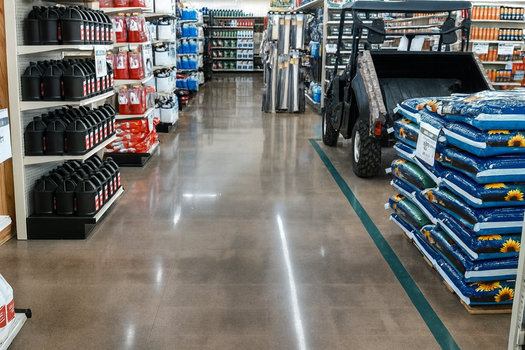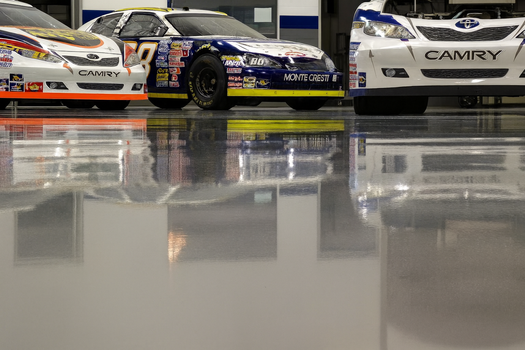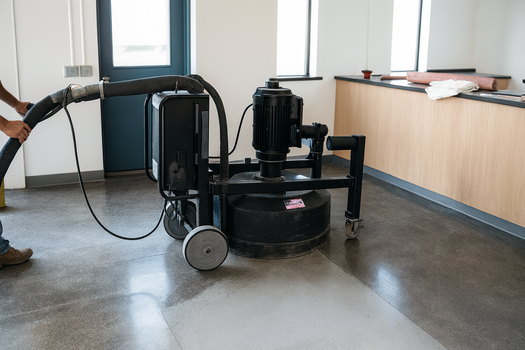Key Considerations in Commercial Concrete Polishing Projects
Once regarded as a niche choice, polished concrete has emerged as one of the most widely adopted flooring systems in commercial construction. From retail spaces to warehouses and modern office towers across Ohio and beyond, its appeal lies in a unique combination of durability, aesthetics, and long-term value. Yet, as straightforward as “polished concrete” may sound, delivering a successful installation requires more than grinding a slab to a high gloss.
Every project unfolds at the intersection of three perspectives: the building manager charged with day-to-day operations, the contractor tasked with execution, and the property owner weighing long-term returns. Understanding how these priorities intersect—and sometimes compete—is the key to transforming concrete into an asset that serves the facility for decades.

Retail: Floors That Shape the Customer Experience
In Ohio’s retail sector, where everything from downtown boutiques to large suburban shopping centers competes for attention, a polished floor is part of the brand. Shoppers may not consciously notice the sheen underfoot, but the impression of cleanliness, modernity, and quality influences how they perceive the space. For building managers, this translates into priorities like slip resistance, easy maintenance, and finishes that align with store identity. Polished concrete’s ability to take on dyes, stains, and logos allows the floor to carry a retailer’s visual language.
But appearances are only half the story. Contractors must address technical realities—ensuring the slab is level, cured, and repaired before the first grinder touches it. With retail projects often pressed into tight timelines, sequencing becomes critical. The floor must be polished after other trades complete their work, yet before final turnover. That demands a firm capable of working overnight, mobilizing quickly, and protecting finished surfaces from damage.
For property owners, polished concrete offers a more strategic advantage: lifecycle value. A single investment in polishing can stretch across decades with minimal upkeep, lowering capital expenditures. Non-slip, VOC-free finishes reduce liability exposure, while the use of the existing slab dovetails with growing sustainability goals. In Ohio’s competitive retail landscape, these advantages increasingly support both tenant attraction and long-term asset performance.

Warehouses: Durability at Scale
Step into one of Ohio’s massive distribution hubs—and the priorities shift immediately. Here, forklifts, pallet jacks, and heavy inventory define the performance requirements. For building managers, polished concrete’s value lies in its durability, dust reduction, and ability to create safer, more efficient workplaces. A smooth, reflective slab reduces tire wear, lowers lighting costs, and improves air quality by keeping fine particles out of circulation.
The scale of warehouse projects presents contractors with their own set of challenges. Tens of thousands of square feet must be polished evenly, requiring industrial-scale equipment, dust-control systems, and large, coordinated crews. Moisture testing and slab flatness checks become essential preconditions. Clear bids that outline each phase—from surface prep to final seal—help avoid ambiguity in projects where downtime can cost thousands per hour.
Owners, meanwhile, calculate ROI in terms of operational savings. Energy reductions, liability mitigation, and reduced cleaning costs all contribute to a facility that is not only functional but marketable. In Ohio’s growing logistics and manufacturing corridors, polished concrete offers an appealing balance of efficiency and sustainability for companies under pressure to optimize both.

Offices: Aesthetic and Functional Balance
Office facilities sit at the crossroads of appearance and occupant comfort. In Ohio’s urban centers—where historic buildings are often repurposed into modern workplaces—polished concrete plays a particularly important role. Managers are drawn to its sleek, contemporary aesthetic and compatibility with corporate branding. Stains, colors, or even embedded logos can extend brand identity right down to the floor plane. Unlike carpet, polished surfaces don’t harbor allergens or dust, contributing to healthier indoor environments.
Yet offices present unique considerations. Hard concrete can amplify sound and feel cold underfoot, prompting designers to integrate rugs or acoustic treatments. Contractors, in turn, must ensure that polishing is sequenced carefully around plumbing, electrical, and HVAC work. Design intent—matte versus high gloss, decorative versus minimalist—must be confirmed early, as these choices become permanent once the polishing process begins.
For owners, polished concrete is increasingly seen as a market differentiator. Lower maintenance costs, reduced energy use through reflectivity and thermal mass, and VOC-free surfaces all align with modern tenant expectations. In Ohio’s competitive leasing market, where tenants demand both sustainability and style, these attributes help position a building as forward-thinking and tenant-friendly.
Perspectives in Contrast
The interplay between stakeholders reveals why polished concrete projects succeed only when priorities are balanced.
Why Polished Concrete Has Staying Power
The Ohio Concrete Association frames it well: polished concrete is a flooring system that combines form and function in ways few other materials can. It leverages the slab that already exists, avoiding additional materials and reducing environmental impact. It delivers measurable performance benefits—durability, safety, energy savings—while offering the design flexibility to meet modern aesthetic demands.
For professionals in construction and facilities management across Ohio, the question is less about whether polished concrete works, and more about how to manage the trade-offs across stakeholders. Those projects that succeed tend to be the ones where contractors, managers, and owners enter with aligned expectations, supported by clear specifications and proven expertise.
In today’s competitive environment, polished concrete has become more than a finish. It is a strategic choice—one that reflects how the industry itself is evolving toward efficiency, sustainability, and long-term value.
